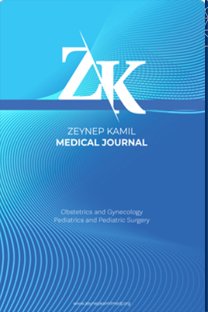Negative pressure wound therapy in gynecological oncology
Negative pressure wound therapy in gynecological oncology
___
- 1. Lynam S, Mark SK, Temkin SM. Primary placement of incisional negative pressure wound therapy at time of laparotomy for gynecologic malignancies. Int J Gynecol Cancer 2016;26:1525–9.
- 2. Bakkum-Gamez JN, Dowdy SC, Borah BJ, Haas LR, Mariani A, Martin JR, et al. Predictors and costs of surgical site infections in patients with endometrial cancer. Gynecol Oncol 2013;130(1):100–6.
- 3. Nugent EK, Hoff JT, Gao F, Massad SL, Case A, Zighelboim I, et al. Wound complications after gynecologic cancer surgery. Gynecol Oncol 2011;121(2):347–52.
- 4. Stanirowski PJ, Wnuk A, Cendrowski K, Sawicki W. Growth factors, silver dressings and negative pressure wound therapy in the management of hard-to-heal postoperative wounds in obstetrics and gynecology: A review. Arch Gynecol Obstet 2015;292(4):757–75.
- 5. Argenta LC, Morykwas MJ. Vacuum assisted closure: A new method for wound control and treatment: Clinical experience. Ann Plast Surg 1997;38:563–76.
- 6. Puri KS, Suresh KR, Gogtay NJ, Thatte UM. Declaration of Helsinki, 2008: İmplications for stake-holders in research. J Postgrad Med 2009;55(6):131–4.
- 7. Surgical Site Infection (SSI) Event: Center for Disease Control. Avaialble from: http://www.cdc.gov/nhsn/PDFs/pscManual/9pscSSIcurrent.pdf?agree= yes&next=Accept. [Last accessed on 2021 Jan 30].
- 8. Wills A, Obermair A. A review of complications associated with the surgical treatment of vulvar cancer. Gynecol Oncol 2013;131(2):467–79.
- 9. Schimp VL, Worley C, Brunello S, Levenback CC, Wolf JK, Sun CC, et al. Vacuum-assisted closure in the treatment of gynecologic oncology wound failures. Gynecol Oncol 2004;92(2):586–91.
- 10. Shackelford DP, Fackler E, Hoffman MK, Atkinson S. Use of topical recombinant human platelet-derived growth factor BB in abdominal wound separation. Am J Obstetr Gynecol 2002;186(4):701–4.
- 11. You C, Han C, Wang X, Zheng Y, Li Q, Hu X, et al. The progress of silver nanoparticles in the antibacterial mechanism, clinical application and cytotoxicity. Mol Biol Rep 2012;39(9):9193–201.
- 12. Morykwas MJ, Argenta LC, Shelton Brown EI, McGuirt W. Vacuum assisted closure: A new method for wound control and treatment: Animal studies and basic foundation. Ann Plast Surg 1997;38(6):553–62.
- 13. Campbell P, Bonham P. Surgical wound case studies with the Versatile 1 wound vacuum system for negative pressure wound therapy. J Wound Ostomy Continence Nurs 2006;33(2):1–16.
- 14. Argenta PA, Rahaman J, Gretz HF, Farr N, Cohen J. Vacuum assisted closure in the treatment of complex gynecologic wound failures. Obstet Gynecol 2002;99(3):497–501.
- 15. Stannard J, Zane Atkins B, O’Malley D, Singh H, Bernstein B, Fahey M, et al. Use of negative pressure therapy on closed surgical incisions: A case series. Ostomy Wound Manage 2009;55(8):58–66.
- 16. Shen P, Blackham AU, Lewis S, Clark CJ, Howerton R, Mogal HD, et al. Phase II randomized trial of negative-pressure wound therapy to decrease surgical site infection in patients undergoing laparotomy for gastrointestinal, pancreatic, and peritoneal surface malignancies. J Am Coll Surg 2017;224(4):726–37.
- 17. Lewis LS, Convery PA, Bolac CS, Valea FA, Lowery WJ, Havrilesky LJ. Cost of care using prophylactic negative pressure wound vacuum on closed laparotomy incisions. Gynecol Oncol 2014;132(3):684–9.
- 18. Perez D, Wildi S, Demartines N, Bramkamp M, Koehler C, Clavien PA. Prospective evaluation of vacuum-assisted closure in abdominal compartment syndrome and severe abdominal sepsis. J Am Coll Surg 2007;205(4):586–92.
- 19. Cro C, George KJ, Donnelly J, Irwin ST, Gardiner KR. Vacuum assisted closure system in the management of enterocutaneous fistulae. Postgrad Med J 2002;78(920):364–5.
- 20. Narducci F, Samouelian V, Marchaudon V, Koenig P, Fournier C, Phalippou J, et al. Vacuum-assisted closure therapy in the management of patients undergoing vulvectomy. Eur J Obstet Gynecol Reprod Biol 2012;161(2):199–201.
- 21. Tauber R, Schmid S, Horn T, Thalgott M, Heck M, Haller B, et al. Inguinal lymph node dissection: Epidermal vacuum therapy for prevention of wound complications. J Plast Reconstr Aesthet Surg 2013;66(3):390–6.
- ISSN: 1300-7971
- Yayın Aralığı: Yılda 4 Sayı
- Yayıncı: Ali Cangül
İbrahim KALE, Cumhur Selçuk TOPAL
Serum endocan concentration in women with placenta accreta
Önder TOSUN, Evrim BOSTANCI, İsmail DAĞ, Enis ÖZKAYA, Çetin KILIÇÇI, Ahmet ESER, Çiğdem YAYLA ABİDE, İlter YENİDEDE
Comparison of outcomes of frozen-thawed transfer of day 5 blastocysts and day 6 blastocysts
Foreign body in esophagus of children with previous esophageal surgery history
Ayşenur CELAYİR, Olga Devrim AYVAZ, Bekir ERDEVE
Negative pressure wound therapy in gynecological oncology
Sevgi KOÇ, Cihat Murat ALINCA, Taner TURAN, Caner ÇAKIR, Dilek YÜKSEL, Çiğdem KILIÇ, Nurettin BORAN, Günsu KİMYON CÖMERT, Fulya KAYIKÇIOĞLU
Anaphylaxis that develops following application of egg white on an area of burn
Zeynep Şengül EMEKSİZ, Serap ÖZMEN
Nurdan EROL, Merve ÖZEN, Abdülkadir BOZAYKUT
Çağatay NUHOĞLU, Nevzat Aykut BAYRAK, Erkan YETMİŞ
Ahmet KALKIŞIM, Gökhan ÇELİK, Betül ÖNAL GÜNAY, Cenap Mahmut ESENÜLKÜ
